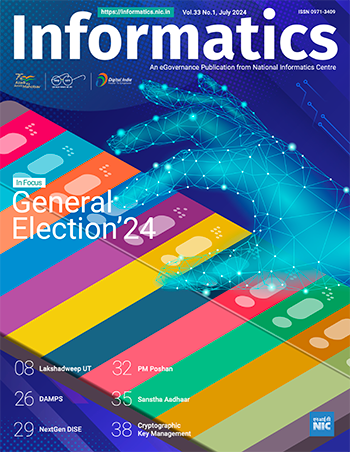Editorial
In the world's largest democracy, India, elections are a fundamental expression of the people's will and a cornerstone of its democratic framework. The Election Commission of India (ECI), established on January 25, 1950, oversees the conduct of free and fair elections. At the heart of this process, the National Informatics Centre (NIC) has played a pivotal role in integrating technology into election management, significantly enhancing the efficiency, transparency, and integrity of the electoral process.
One of NIC's most notable contributions is the computerization of electoral rolls. This monumental task began in 1998 when NIC digitized the electoral rolls of 620 million voters. This digitization significantly improved the accuracy and reliability of voter data, reducing errors and minimizing opportunities for fraudulent entries. The maintenance of up-to-date and precise electoral rolls is crucial for a fair electoral process, and NIC’s efforts in this regard have been transformative.
To further bolster electoral integrity, NIC facilitated the introduction of Elector Photo Identity Cards (EPIC) for voters. These cards are essential in preventing impersonation and ensuring that each vote cast is legitimate. The implementation of the Electoral Rolls Management System by NIC has streamlined the preparation, revision, and maintenance of electoral rolls, making these processes more efficient and transparent.
NIC’s technological expertise extends to operational aspects of election management. The organization provides systems for the drafting and deployment of polling personnel, randomization of Electronic Voting Machines (EVMs), and the appointment of sector and zonal magistrates. These pre-poll activities are critical for logistical planning and ensure the smooth conduct of elections.
On election day, NIC’s ICT solutions provide crucial real-time monitoring and transparency. The Communication Plan for Election Tracking (ComET) tracks election milestones and polling progress via SMS, enabling swift issue reporting and resolution. NIC also facilitates live webcasting and video streaming from polling stations, allowing officials, political parties, and the public to observe the process, enhancing trust and accountability.
After voting, NIC oversees the counting of votes and dissemination of results. Its computerized systems ensure accurate vote counting and transmit results to the Chief Electoral Officers (CEOs) and the ECI, ensuring timely reporting. It also sets up media centers at counting locations for efficient result dissemination and employs Geographic Information Systems (GIS) for election management, aiding in polling station rationalization and election data visualization.
Through its comprehensive and innovative ICT solutions, NIC has greatly strengthened India’s democratic values by ensuring elections are conducted with integrity and transparency. As technology evolves, NIC continues to lead, enhancing the robustness and resilience of India’s electoral process. NIC remains committed to innovation, as demonstrated by its cutting-edge tools like NextGEN DISE, which further streamline and modernize election management, ensuring a secure and efficient democratic process.
—Editor-In-Chief

